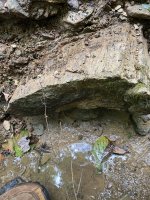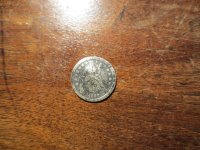piratediver
Sr. Member
Especially for Diverlynn as it mentions Peru quite a bit.
Forging Ahead Volume 62 Number 3, May/June 2009
by Charles Stanish
Or, how I learned to stop worrying and love eBay
The auction site eBay is packed with objects purported to be ancient, like this "XTREME!" Moche-style ceramic vessel.
A little over a decade ago, archaeologists experienced a collective nightmare--the emergence of eBay, the Internet auction site that, among other things, lets people sell looted artifacts. The black market for antiquities has existed for centuries, of course, with devastating consequences for the world's cultural heritage. But we could at least take some comfort that it was largely confined to either high-end dealers on one end of the economic spectrum or rural flea markets on the other. The sheer physical constraints of transporting and selling illegal artifacts kept the market relatively small. But the rise of online auction sites promised to drastically alter the landscape. And so it did, just not in the dire way we had anticipated.
Back in the pre-eBay days, the cost of acquiring and selling an antiquity was high. The actual looter was usually paid little, but various middlemen down the line added huge costs. During my 25 years of working in the Andes, I have often seen this dynamic at work. In years past, transporting an object was a big expense, even for portable artifacts, and the potential for arrest added to the total cost of doing business. In addition, the expense of authentication, conservation, and occasional restoration of the pieces, made buying and selling quality antiquities a wealthy person's vice.
Our greatest fear was that the Internet would democratize antiquities trafficking and lead to widespread looting. This seemed a logical outcome of a system in which anyone could open up an eBay site and sell artifacts dug up by locals anywhere in the world. We feared that an unorganized but massive looting campaign was about to begin, with everything from potsherds to pieces of the Great Wall on the auction block for a few dollars. But a very curious thing has happened. It appears that electronic buying and selling has actually hurt the antiquities trade.
How is it possible? The short answer is that many of the primary "producers" of the objects have shifted from looting sites to faking antiquities. I've been tracking eBay antiquities for years now, and from what I can tell, this shift began around 2000, about five years after eBay was established. It is true that fakes have been around for centuries. In 1886, the celebrated Smithsonian archaeologist W. H. Holmes described countless bogus antiquities in Mexico. A few decades later, Egyptologist T. G. Wakeling noted that many ancient Egyptian artifacts were, in fact, fakes. In the 19th century, American and European museums purchased large numbers of "Etruscan" ceramic vessels and sarcophagi that came straight from the kilns of rural Italian farmers. But these were usually the really good fakes, labor-intensive pieces that required lots of work and skill. Today, every grade and kind of antiquity is being mass-produced and sold in quantities too large to imagine.
In the pre-Internet days, no one thought that so many people would be willing to put down good money for a low-end piece of tourist art. People who used to make a few dollars selling a looted artifact to a middleman in their village can now produce their own "almost-as-good-as-old" objects and go directly to a person in a nearby town who has an eBay vendor account. They will receive the same amount or even more than they could have received for actual antiquities. I have visited a number of these workshops in Peru and Bolivia. Using local materials and drawing on their cultural knowledge, small manufacturers can produce pieces that are, in some cases, remarkably accurate reproductions of actual artifacts. The really smart ones do not reproduce pieces at all but create an ever-so-slightly modified version of real artifacts that have the look and feel of an authentic ancient object. Perhaps the ultimate achievement is the work of the famous Brigido Lara, who created tens of thousands of fakes in the 1950s and '60s, practically creating his own "ancient" culture in Veracruz, Mexico, in the process.
Forged Andean artifacts are becoming increasingly sophisticated, as illustrated by this exact reproduction of a Moche portrait vessel by artisan Walter Acosta. (Charles Stanish)
The economics of these transactions are quite simple. Because the eBay phenomenon has substantially reduced total costs by eliminating middlemen, brick-and-mortar stores, high-priced dealers, and other marginal expenses, the local eBayers and craftsmen can make more money cranking out cheap fakes than they can by spending days or weeks digging around looking for the real thing. It is true that many former and potential looters lack the skills to make their own artifacts. But the value of their illicit digging decreases every time someone buys a "genuine" Moche pot for $35, plus shipping and handling. In other words, because the low-end antiquities market has been flooded with fakes that people buy for a fraction of what a genuine object would cost, the value of the real artifacts has gone down as well, making old-fashioned looting less lucrative. The value of real antiquities is also impacted by the increased risk that the object for sale is a fake. The likelihood of reselling an authentic artifact for more money is diminished each year as more fakes are produced.
Another economic factor--risk of arrest--is also removed by eBay fakes, since you can't be arrested for importing forgeries. Should you import what you think is an illegal antiquity but it turns out to be a fake, you run little risk of prosecution. The risk from lawsuits or criminal charges is effectively removed from the sale of antiquities when they are not really antiquities, a fact that reduces the cost and risk to both buyer and seller.
Transport cost is also dramatically reduced by commerce on the Web. One vendor on eBay advertises a Greek marble head dated to around 300 B.C. For this "rare artifact," the shipping costs from Cyprus are a whopping $35 to anywhere in the United States. This is a far cry from the old days when a real illegal antiquity had to be couriered by a specialist who not only knew how to care for the piece, but how to doctor it up to avoid being arrested at customs. The same is true for objects from just about every well-known ancient culture in the world. Chinese, Bulgarian, Egyptian, Peruvian, and Mexican workshops are now producing fakes at a frenetic pace.
Even more remarkable than the growing demand for cheap fakes is the fact that the low-end market phenomenon is actually distorting the mid-range and lower high-end markets as well. Again, this seems counterintuitive. How could the selling of bad fakes and tacky tourist art as inexpensive antiquities distort the higher-end markets? Surely the sophisticated high-end buyers would not be affected by the rubes who pay $223 (plus $30 shipping from Lima) for a "genuine pre-Columbian Moche III Fineline" piece (which, by the way, can also be bought for $15 from the woman selling pottery outside the tourist buses in the Peruvian city of Trujillo).
But the high-enders are indeed affected. It was only a matter of time before a few workshops producing the cheap fakes started turning out reproductions that can fool even supposed experts like me. A number of these workshops have swamped the higher-end market with beautiful pieces that require intensive study by specialists and high-cost tests to authenticate. This manufacturing business never could have developed on such a scale without the Internet, and these forgers have forever transformed the antiquities market into something that we could not have imagined just a decade ago.
The daughter of a Peruvian artisan who specializes in reproducing ancient objects holds an example of her work. (Charles Stanish)
The wealthier collector who up to now has been laughing about the naive folks who buy on eBay is in for a surprise, too: those dealers that provide private sales are some of the forgers' best customers, knowingly or otherwise. In fact, the workshops reserve their "finest" pieces for collectors using the same backdoor channels as before, but now with a much higher profit margin because they are selling fakes. As a former curator myself, I know that an embarrassingly high percentage of objects in our museums are forgeries. What fools the curator also fools the collector.
From the professional's point of view, there are really three kinds of "antiquities" on eBay. About 30 percent are obvious fakes or tourist art that can be detected by looking at the pictures, even the fuzzy ones. These are easy to pick out because they are not intentional reproductions, but simple pieces manufactured for tourists and sold as such. The creators of these pieces mix up iconography and choose colors and shapes for visual effect. Such objects are clearly not ancient. Another five percent or so are probably real, while the rest are in the ambiguous category of "I would have to hold it in my hand to be able to make an informed decision." This latter category has grown fast.
In the first years of eBay, I observed about a 50-50 real-to-fake ratio in Andean artifacts. About five years ago, my informal assessment was that about 95 percent were obvious fakes and the rest were real or dubious. This was the period when the workshops first went into high gear; the market was flooded with low-end junk. Now, the workshops are producing much higher-quality fakes, increasing the category of ambiguous objects now available.
I base these estimates not only on what I see on eBay, but also from my occasional work with U.S. Customs, in which I help authenticate objects. Additionally, I am fascinated with antiquities dealers and "manufacturers" in South America. I've learned much by hanging around the men and women who produce these objects. I know, for instance, of one fellow who makes grass-tempered reproductions of a 2,000-year-old pottery style. Having worked on archaeological projects for years, he learned to get the grass for his fakes from ancient middens near his house. If fired properly, and if the organic residue in one of his pots were carbon dated, it would appear to be a very old piece indeed. Looters on the north coast of Peru have discovered not only the famous 12th-15th-century A.D. Chancay anthropomorphic vessels, but also the original molds used to make the vessels. Thanks to publicly available archaeological reports, they also now use the original clay sources and minerals to make and paint the pottery. They can create virtually perfect reproductions.
In an antiquities store in La Paz, I recently saw about four shelves of supposed Tiwanaku (ca. A.D. 400-1000) pottery. I told the owner that most were fakes and she became irritated and called me a liar. So I simply touched one at a time, saying "fake," "real," "real from Tiwanaku," "fake," "fake made by Eugenio in Fuerabamba," and so forth. She paused for a moment, pulled one down that I said was real, and told me that it was also a fake. I congratulated her on the fact that her fakes were getting better and she just smiled. My mistake is an instance of what San Francisco State University archaeologist Karen Olsen Bruhns has identified as a very real problem--the experts who study the objects are sometimes being trained on fakes. As a result, they may authenticate pieces that are not real.
After dominating the online market, obvious fakes have given way to "artifacts" that even experts have trouble authenticating.
You can use thermoluminescence dating, which determines the amount of time elapsed since a clay object was fired, to definitively establish the antiquity of a pottery vessel, if it is old enough. However, the cost of hiring a professional to take the sample and run the analysis is high for mid-range market, one sample can cost as much as $400. Since forgers commonly include fragments of ancient pottery in their work, multiple samples are necessary, making thermoluminescence dating prohibitively expensive for the low-end market. Some eBay vendors are brilliant in this regard. They state that they will return a buyer's money if they have a letter from a recognized specialist that proves the piece not to be authentic. However, this guarantee is nullified if you conduct any kind of "destructive" analysis on the object. To the nonspecialist this seems reasonable. However, the sampling of a few specks of clay from a vessel for thermoluminescence dating by a professional conservator is not even noticeable to the naked eye. While standard procedure in the museum world, this is technically a type of destructive analysis. It nullifies the guarantee, but it is the only way that a recognized specialist can possibly prove the authenticity of a piece of ancient pottery. As a result, the guarantee is meaningless.
Well-made stone and metal reproductions are almost impossible to authenticate. Some kinds of spectrographic analyses can rule out certain objects as fakes. But if the ancient source materials are used by the producers, it is very difficult to prove definitively whether a piece is authentic or not. The auctions on eBay are full of stone objects purported to be ancient. With the advent of laser lathes and chemical techniques to forge patinas, anyone who buys an "Assyrian alabaster stone Mask 700 B.C." or "Ancient Chinese Jade Carvings-Frog Arrowhead" thinking that they are real antiquities is, in my opinion, a thoroughly naive fool.
There is another looming factor that dealers rarely discuss. As the sophistication in forgeries continues to increase, museums, law enforcement, and other institutions charged with protecting our cultural heritage will look for even more reliable means of authenticating objects. A time will come when technology will outpace the looter and antiquities dealer. The cost of these technologies will likely always fall over time, but the price of professional labor will always rise, adding another expense for dealers. Like radiocarbon dates for organic objects, the application of these new techniques will become standard practice for all antiquities bought and sold. This will also inject a new element of risk for the buyer that will dramatically add to the risk of illicit, high-end trafficking. Who wants to spend $50,000 on an object "guaranteed" to be ancient by today's standards, when someone can come along in five years with a new technology that definitively proves it to be a fake?
So where does the illegal antiquities market go from here? Certainly, looting will continue. There will always be the gamblers who do not act economically rational and will continue to look for a jackpot. The highest-end dealers will be around for a long time, but with significantly higher marginal costs associated with their illicit trade. But for most of us the Web has forever distorted the antiquities trafficking market in a positive way.
There have always been Moche, Chimu, and Nasca reproductions that were difficult to distinguish from the real thing, but in recent years I have seen many, many more. The traditional workshops in the Peruvian towns of Piura and Ica have been around for decades and the quality of their high-end products continues to rise. Workshops in new tourist destinations such as Puno and Ayacucho are popping up every year. As the fakes increase in both quality and sheer numbers, the real antiquities and the obvious fakes available will decrease. If you can sell a $15 Moche knockoff for $200, imagine what you can do with a really good reproduction. We can only hope, but it is just conceivable that online commerce will actually put a lot of antiquities looters and traffickers out of business by the sheer volume of sales and quality of products that fool even the experts.
What drives this new dynamic is the small fraction of people who actually believe that someone will sell you a real Moche Fineline pot for $200 (actual price: about $15,000) and have it shipped from Peru by mail without any risk. It is this money that provides the capital for the cottage industries to keep producing and fueling the cycle of ever-increasing quality and quantity of forgeries. There is, in reality, no mystery to all of this. It is the logical outcome of all buyers, sellers, and producers acting in their individual economic self-interest. I suppose if people stopped believing that they can buy a pill that will help them lose weight without dieting or exercise, then it is possible that people will stop buying fakes online, and we will return to old-fashioned looting. We just have to wait and see what surprises the Internet brings us in the future.
Charles Stanish is director of the Cotsen Institute of Archaeology and a professor of anthropology at UCLA. A version of this article first appeared in the Cotsen Institute's publication Backdirt (2008).
Pirate Diver
Forging Ahead Volume 62 Number 3, May/June 2009
by Charles Stanish
Or, how I learned to stop worrying and love eBay
The auction site eBay is packed with objects purported to be ancient, like this "XTREME!" Moche-style ceramic vessel.
A little over a decade ago, archaeologists experienced a collective nightmare--the emergence of eBay, the Internet auction site that, among other things, lets people sell looted artifacts. The black market for antiquities has existed for centuries, of course, with devastating consequences for the world's cultural heritage. But we could at least take some comfort that it was largely confined to either high-end dealers on one end of the economic spectrum or rural flea markets on the other. The sheer physical constraints of transporting and selling illegal artifacts kept the market relatively small. But the rise of online auction sites promised to drastically alter the landscape. And so it did, just not in the dire way we had anticipated.
Back in the pre-eBay days, the cost of acquiring and selling an antiquity was high. The actual looter was usually paid little, but various middlemen down the line added huge costs. During my 25 years of working in the Andes, I have often seen this dynamic at work. In years past, transporting an object was a big expense, even for portable artifacts, and the potential for arrest added to the total cost of doing business. In addition, the expense of authentication, conservation, and occasional restoration of the pieces, made buying and selling quality antiquities a wealthy person's vice.
Our greatest fear was that the Internet would democratize antiquities trafficking and lead to widespread looting. This seemed a logical outcome of a system in which anyone could open up an eBay site and sell artifacts dug up by locals anywhere in the world. We feared that an unorganized but massive looting campaign was about to begin, with everything from potsherds to pieces of the Great Wall on the auction block for a few dollars. But a very curious thing has happened. It appears that electronic buying and selling has actually hurt the antiquities trade.
How is it possible? The short answer is that many of the primary "producers" of the objects have shifted from looting sites to faking antiquities. I've been tracking eBay antiquities for years now, and from what I can tell, this shift began around 2000, about five years after eBay was established. It is true that fakes have been around for centuries. In 1886, the celebrated Smithsonian archaeologist W. H. Holmes described countless bogus antiquities in Mexico. A few decades later, Egyptologist T. G. Wakeling noted that many ancient Egyptian artifacts were, in fact, fakes. In the 19th century, American and European museums purchased large numbers of "Etruscan" ceramic vessels and sarcophagi that came straight from the kilns of rural Italian farmers. But these were usually the really good fakes, labor-intensive pieces that required lots of work and skill. Today, every grade and kind of antiquity is being mass-produced and sold in quantities too large to imagine.
In the pre-Internet days, no one thought that so many people would be willing to put down good money for a low-end piece of tourist art. People who used to make a few dollars selling a looted artifact to a middleman in their village can now produce their own "almost-as-good-as-old" objects and go directly to a person in a nearby town who has an eBay vendor account. They will receive the same amount or even more than they could have received for actual antiquities. I have visited a number of these workshops in Peru and Bolivia. Using local materials and drawing on their cultural knowledge, small manufacturers can produce pieces that are, in some cases, remarkably accurate reproductions of actual artifacts. The really smart ones do not reproduce pieces at all but create an ever-so-slightly modified version of real artifacts that have the look and feel of an authentic ancient object. Perhaps the ultimate achievement is the work of the famous Brigido Lara, who created tens of thousands of fakes in the 1950s and '60s, practically creating his own "ancient" culture in Veracruz, Mexico, in the process.
Forged Andean artifacts are becoming increasingly sophisticated, as illustrated by this exact reproduction of a Moche portrait vessel by artisan Walter Acosta. (Charles Stanish)
The economics of these transactions are quite simple. Because the eBay phenomenon has substantially reduced total costs by eliminating middlemen, brick-and-mortar stores, high-priced dealers, and other marginal expenses, the local eBayers and craftsmen can make more money cranking out cheap fakes than they can by spending days or weeks digging around looking for the real thing. It is true that many former and potential looters lack the skills to make their own artifacts. But the value of their illicit digging decreases every time someone buys a "genuine" Moche pot for $35, plus shipping and handling. In other words, because the low-end antiquities market has been flooded with fakes that people buy for a fraction of what a genuine object would cost, the value of the real artifacts has gone down as well, making old-fashioned looting less lucrative. The value of real antiquities is also impacted by the increased risk that the object for sale is a fake. The likelihood of reselling an authentic artifact for more money is diminished each year as more fakes are produced.
Another economic factor--risk of arrest--is also removed by eBay fakes, since you can't be arrested for importing forgeries. Should you import what you think is an illegal antiquity but it turns out to be a fake, you run little risk of prosecution. The risk from lawsuits or criminal charges is effectively removed from the sale of antiquities when they are not really antiquities, a fact that reduces the cost and risk to both buyer and seller.
Transport cost is also dramatically reduced by commerce on the Web. One vendor on eBay advertises a Greek marble head dated to around 300 B.C. For this "rare artifact," the shipping costs from Cyprus are a whopping $35 to anywhere in the United States. This is a far cry from the old days when a real illegal antiquity had to be couriered by a specialist who not only knew how to care for the piece, but how to doctor it up to avoid being arrested at customs. The same is true for objects from just about every well-known ancient culture in the world. Chinese, Bulgarian, Egyptian, Peruvian, and Mexican workshops are now producing fakes at a frenetic pace.
Even more remarkable than the growing demand for cheap fakes is the fact that the low-end market phenomenon is actually distorting the mid-range and lower high-end markets as well. Again, this seems counterintuitive. How could the selling of bad fakes and tacky tourist art as inexpensive antiquities distort the higher-end markets? Surely the sophisticated high-end buyers would not be affected by the rubes who pay $223 (plus $30 shipping from Lima) for a "genuine pre-Columbian Moche III Fineline" piece (which, by the way, can also be bought for $15 from the woman selling pottery outside the tourist buses in the Peruvian city of Trujillo).
But the high-enders are indeed affected. It was only a matter of time before a few workshops producing the cheap fakes started turning out reproductions that can fool even supposed experts like me. A number of these workshops have swamped the higher-end market with beautiful pieces that require intensive study by specialists and high-cost tests to authenticate. This manufacturing business never could have developed on such a scale without the Internet, and these forgers have forever transformed the antiquities market into something that we could not have imagined just a decade ago.
The daughter of a Peruvian artisan who specializes in reproducing ancient objects holds an example of her work. (Charles Stanish)
The wealthier collector who up to now has been laughing about the naive folks who buy on eBay is in for a surprise, too: those dealers that provide private sales are some of the forgers' best customers, knowingly or otherwise. In fact, the workshops reserve their "finest" pieces for collectors using the same backdoor channels as before, but now with a much higher profit margin because they are selling fakes. As a former curator myself, I know that an embarrassingly high percentage of objects in our museums are forgeries. What fools the curator also fools the collector.
From the professional's point of view, there are really three kinds of "antiquities" on eBay. About 30 percent are obvious fakes or tourist art that can be detected by looking at the pictures, even the fuzzy ones. These are easy to pick out because they are not intentional reproductions, but simple pieces manufactured for tourists and sold as such. The creators of these pieces mix up iconography and choose colors and shapes for visual effect. Such objects are clearly not ancient. Another five percent or so are probably real, while the rest are in the ambiguous category of "I would have to hold it in my hand to be able to make an informed decision." This latter category has grown fast.
In the first years of eBay, I observed about a 50-50 real-to-fake ratio in Andean artifacts. About five years ago, my informal assessment was that about 95 percent were obvious fakes and the rest were real or dubious. This was the period when the workshops first went into high gear; the market was flooded with low-end junk. Now, the workshops are producing much higher-quality fakes, increasing the category of ambiguous objects now available.
I base these estimates not only on what I see on eBay, but also from my occasional work with U.S. Customs, in which I help authenticate objects. Additionally, I am fascinated with antiquities dealers and "manufacturers" in South America. I've learned much by hanging around the men and women who produce these objects. I know, for instance, of one fellow who makes grass-tempered reproductions of a 2,000-year-old pottery style. Having worked on archaeological projects for years, he learned to get the grass for his fakes from ancient middens near his house. If fired properly, and if the organic residue in one of his pots were carbon dated, it would appear to be a very old piece indeed. Looters on the north coast of Peru have discovered not only the famous 12th-15th-century A.D. Chancay anthropomorphic vessels, but also the original molds used to make the vessels. Thanks to publicly available archaeological reports, they also now use the original clay sources and minerals to make and paint the pottery. They can create virtually perfect reproductions.
In an antiquities store in La Paz, I recently saw about four shelves of supposed Tiwanaku (ca. A.D. 400-1000) pottery. I told the owner that most were fakes and she became irritated and called me a liar. So I simply touched one at a time, saying "fake," "real," "real from Tiwanaku," "fake," "fake made by Eugenio in Fuerabamba," and so forth. She paused for a moment, pulled one down that I said was real, and told me that it was also a fake. I congratulated her on the fact that her fakes were getting better and she just smiled. My mistake is an instance of what San Francisco State University archaeologist Karen Olsen Bruhns has identified as a very real problem--the experts who study the objects are sometimes being trained on fakes. As a result, they may authenticate pieces that are not real.
After dominating the online market, obvious fakes have given way to "artifacts" that even experts have trouble authenticating.
You can use thermoluminescence dating, which determines the amount of time elapsed since a clay object was fired, to definitively establish the antiquity of a pottery vessel, if it is old enough. However, the cost of hiring a professional to take the sample and run the analysis is high for mid-range market, one sample can cost as much as $400. Since forgers commonly include fragments of ancient pottery in their work, multiple samples are necessary, making thermoluminescence dating prohibitively expensive for the low-end market. Some eBay vendors are brilliant in this regard. They state that they will return a buyer's money if they have a letter from a recognized specialist that proves the piece not to be authentic. However, this guarantee is nullified if you conduct any kind of "destructive" analysis on the object. To the nonspecialist this seems reasonable. However, the sampling of a few specks of clay from a vessel for thermoluminescence dating by a professional conservator is not even noticeable to the naked eye. While standard procedure in the museum world, this is technically a type of destructive analysis. It nullifies the guarantee, but it is the only way that a recognized specialist can possibly prove the authenticity of a piece of ancient pottery. As a result, the guarantee is meaningless.
Well-made stone and metal reproductions are almost impossible to authenticate. Some kinds of spectrographic analyses can rule out certain objects as fakes. But if the ancient source materials are used by the producers, it is very difficult to prove definitively whether a piece is authentic or not. The auctions on eBay are full of stone objects purported to be ancient. With the advent of laser lathes and chemical techniques to forge patinas, anyone who buys an "Assyrian alabaster stone Mask 700 B.C." or "Ancient Chinese Jade Carvings-Frog Arrowhead" thinking that they are real antiquities is, in my opinion, a thoroughly naive fool.
There is another looming factor that dealers rarely discuss. As the sophistication in forgeries continues to increase, museums, law enforcement, and other institutions charged with protecting our cultural heritage will look for even more reliable means of authenticating objects. A time will come when technology will outpace the looter and antiquities dealer. The cost of these technologies will likely always fall over time, but the price of professional labor will always rise, adding another expense for dealers. Like radiocarbon dates for organic objects, the application of these new techniques will become standard practice for all antiquities bought and sold. This will also inject a new element of risk for the buyer that will dramatically add to the risk of illicit, high-end trafficking. Who wants to spend $50,000 on an object "guaranteed" to be ancient by today's standards, when someone can come along in five years with a new technology that definitively proves it to be a fake?
So where does the illegal antiquities market go from here? Certainly, looting will continue. There will always be the gamblers who do not act economically rational and will continue to look for a jackpot. The highest-end dealers will be around for a long time, but with significantly higher marginal costs associated with their illicit trade. But for most of us the Web has forever distorted the antiquities trafficking market in a positive way.
There have always been Moche, Chimu, and Nasca reproductions that were difficult to distinguish from the real thing, but in recent years I have seen many, many more. The traditional workshops in the Peruvian towns of Piura and Ica have been around for decades and the quality of their high-end products continues to rise. Workshops in new tourist destinations such as Puno and Ayacucho are popping up every year. As the fakes increase in both quality and sheer numbers, the real antiquities and the obvious fakes available will decrease. If you can sell a $15 Moche knockoff for $200, imagine what you can do with a really good reproduction. We can only hope, but it is just conceivable that online commerce will actually put a lot of antiquities looters and traffickers out of business by the sheer volume of sales and quality of products that fool even the experts.
What drives this new dynamic is the small fraction of people who actually believe that someone will sell you a real Moche Fineline pot for $200 (actual price: about $15,000) and have it shipped from Peru by mail without any risk. It is this money that provides the capital for the cottage industries to keep producing and fueling the cycle of ever-increasing quality and quantity of forgeries. There is, in reality, no mystery to all of this. It is the logical outcome of all buyers, sellers, and producers acting in their individual economic self-interest. I suppose if people stopped believing that they can buy a pill that will help them lose weight without dieting or exercise, then it is possible that people will stop buying fakes online, and we will return to old-fashioned looting. We just have to wait and see what surprises the Internet brings us in the future.
Charles Stanish is director of the Cotsen Institute of Archaeology and a professor of anthropology at UCLA. A version of this article first appeared in the Cotsen Institute's publication Backdirt (2008).
Pirate Diver


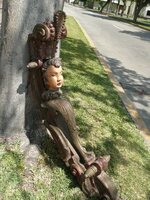
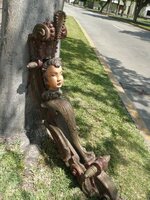
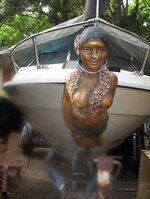
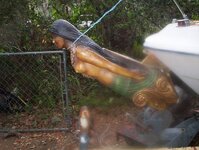


 --- I love the butterfly trays they have down there --did you get one? --the blue colored ones are so nice.
--- I love the butterfly trays they have down there --did you get one? --the blue colored ones are so nice.
